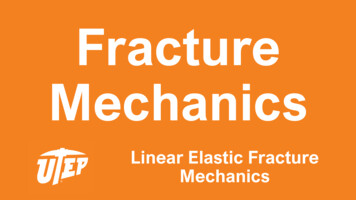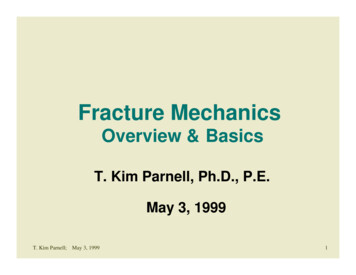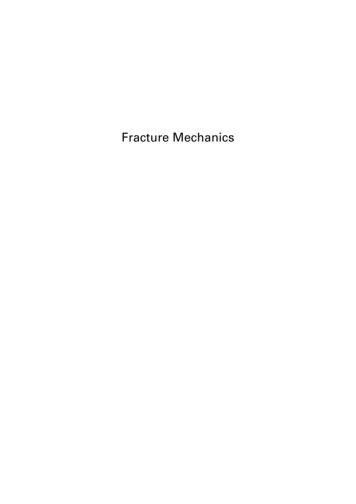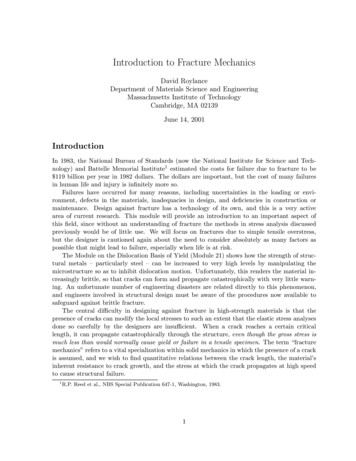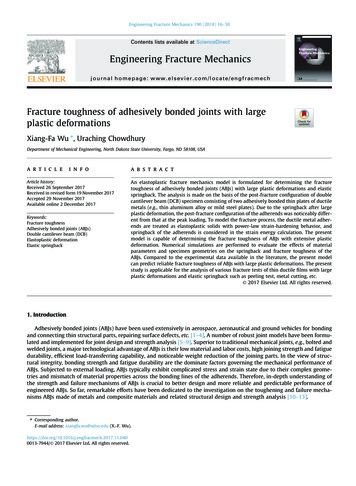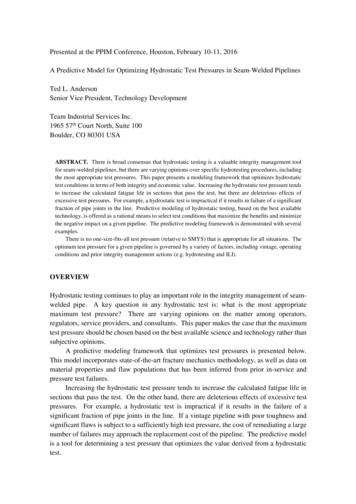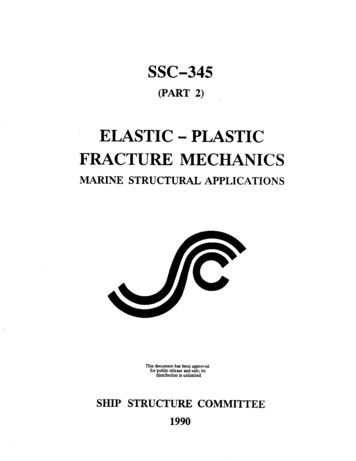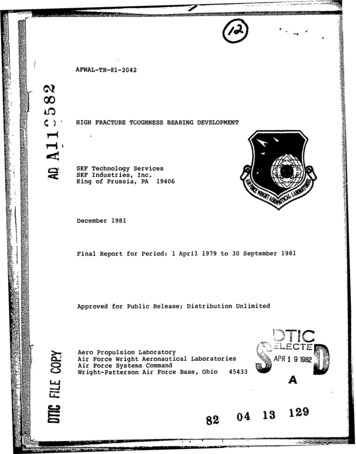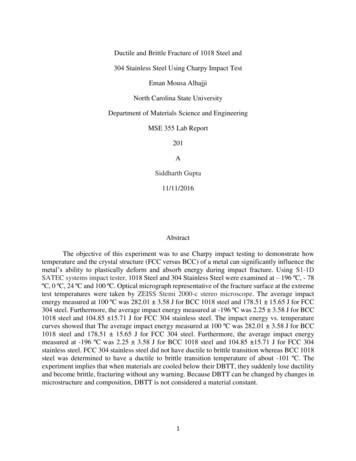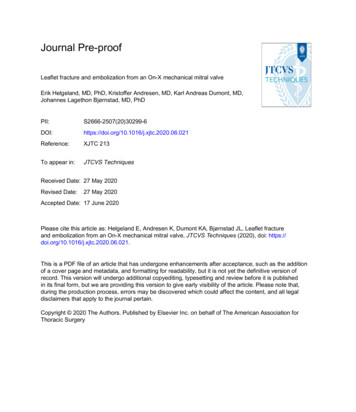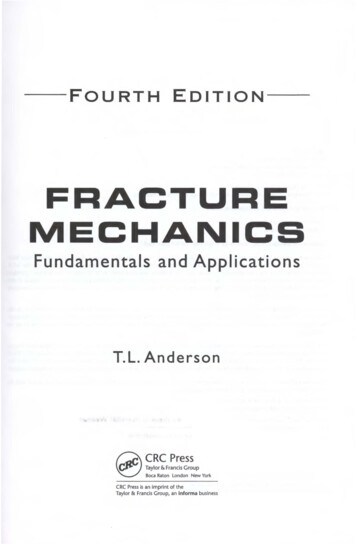
Transcription
--FOURTH EDITION--FRACTUREMECHANICSFundamentals and ApplicationsT.L. Anderson )1 r?Fr p Boca Raton London New YorkCRC Press is an imprlnt of theTaylor & Francis Group, an lnforma business
Contents „.„. . . . . . . . . . . . . . . . ···············XVSection 1 Introduction1. History and Overview .„„ . „„ . „. „„„„ . „„ . „. „. „. „ . „. 31.1 Why Structures Fail . „ . „ . „.„ . „„„„ . „.„.„ . „ . „. „. 31.2 Historical Perspective.„ . „. „„„ . „„ . 61.2.1 Early Fracture �„„„„„„„„„.81.2.2 The Liberty Sbips.„ . „„ . „„ . „„ . „. „ . „. „„„„ . „„„ . „„„ . „„ . „. 81.2.3 Postwar Fracture Mechanics Research „.„„„„„„„„„„ 91.2.4 Fracture Mechanics from 1960 through „„„„„„„ 101.2.5 Fracture Mechanics from 1980 to the Present.„„„„„ . „.„„.„„ . „„„„„„„„.121.3 The Fracture Mechanics Approach to Design .„„ . �„„„„„„.„ 121.3.1 The Energy Criterion„.„ . „. „.„„.„.„„.„.„„„„ . �.„.„„„131.3.2 The Stress Intensity �„„. 141.3.3 Time-Dependent Crack Growth and Damage Tolerance „„„„„„„„„„„„. 151.4 Effect of Material Properties on Fracture „„„„„„„„„. „ ��„„„„ 161.5 A Brief Review of Dimensional Analysis .„.„„„„„„„„.„.„„„ 171.5.1 The Buckingham „„„„„„.„„.„ . „„.„.„„„.„.„.181.5.2 Dimensional Analysis in Fracture �„„„„„„„19References „„„„ . „.„.„ . . „. „„„„„„„„ . „.;:.„„„„„ . „.„ . . „. . „ . „. 21Section II Fundamental Concepts2. Linear Elastic Fracture Mechanics �„.„„„.„„ 252.1 An Atomic View of Fracture„„„„„.„.„„„„ . �„„„„„„„„„„„„„. 252.2 Stress Concentration Effect of Flaws �.„ 272.3 The Griffith Energy Balance . „. „. „„„„„„„„„. 302.3.1 Comparison with the Critical Stress Criterion „„„.„„.„„„„„„ . „„.„„„„„. 322.3.2 Modified Griffith Equation . „. „. „. „. „„ . „. „. „„ . „. „. „ 332.4 Energy Release Rate.„ . „. „. „. „. „. „. „„ . „„ . „„„ . „. „. „. 352.5 Instability and the R Curve „„„.„„„„„„„„.„„„„„ . „.„„„ . „„„„„„„„ . „„„„„„„.„„. „ 392.5.1 Reasons for the R Curve Shape„„ . �„„„„„„„.„„„.„.„402.5.2 Load Control versus Displacement Control.„„ . „„ . „.„„.„„ . „„ . „„„„„. 412.5.3 Structures with Finite Compliance . „.„.„„.„ . „„.„.„„„ . „„„.„.„„„„„„.„422.6 Stress Analysis of Cracks „„„„„„ . „„ . „„„„.:„„„ . „. „„ . „.„ . „. „. „„ . „„„442.6.l The Stress Intensity Factot. „ . „. „.„„ . „. „.„„„.„.„442.6.2 Relationship between K and Global Behavior �„„„. 472.6.3 Effect of Finite Size .„„„„„.„.„„.„„.„„ . „.„„ . „. „.„.„„ . „.„„.„ . „.„„ . „. „.„ 512.6.4 Principle of Superposition „„„„.„„„.„„.„„ . „„„„.„„„„ . „„„„„„„„„„„„„„„ 552.6.5 Weight Functions . „.,. „„ . „. „. 57vii
ContentsviiiRelationship between K and q. . „ . „ . „ .„ . „„.„ 60Crack Tip Plasticity . 622.8.1 The Irwin Approach . „. 632.8.2 The Strip Yield Model . 662.8.3 Comparison of Plastic Zone Corrections. 682.8.4 Plastic Zone Shape . „. 692.9 K-Controlled Fracture .„. „„ . „ . „ . „ . 712.10 Plane Strain Fracture: Fact versus Fiction . „ .„ . 752.10.1 Crack Tip Triax.iality. „ .„ . „. „„ . 762.10.2 Effect of Thickness on Apparent Fracture Toughness . „ . 782.10.3 Plastic Zone Effects„.„ .„ . „ . „„ . „ . . . „.„„. „ . „„. 812.10.4 Implications for Cracks in Structures . „ .„„ . „.„ . „. „ . 832.11 Mixed-Mode Fracture . „„ . „ . „ . „„„ .„ . . „. „„„ . 842.11.l Propagation of an Angled Crack . „ . 852.11.2 Equivalent Mode I Crack . „ . 872.11.3 Biaxial Loading .„ . „ . „ . 882.12 Interaction of Multiple Cracks . „ .„ .„ . „ . „ . „ 902.12.1 Coplanar Cracks. „ . „.„ .„„ . . „.„ . 902.12.2 Parallel Cracks . „.„ . .„ .„„. 90Appendix 2A: Mathematical Foundations of Linear Elastic FractureMechanics: Selected Results . „ . 92References .„ . .„. „„ . 1072.72.83. Elastic-Plastic Fracture Mechanics . „ . „ . „ . 1093.1 Crack Tip Opening Displacement . „„„„„ . „ . „ .„. 1093.2 The JContour Integral.„„ . „.„„„ . „. „ .„ . 1143.2.1 Nonlinear Energy Release Rate .„ .„ . „. „. 1153.2.2 Jas a Path-Independent Line Integral. . „„ . „„ . 1173.2.3 Jas a Stress Intensity Parameter .„ . „. 1183.2.4 The Large-Strain Zone .„. 1193.2.5 Laboratory Measurement of f. . 1213.3 Relationships between Jand CTOD . „. 1273.4 Crack Growth Resistance Curves . 1293.4.1 Stahle and Unstable Crack Growth . „.„. „.„ . „. 1313.4.2 Computing Jfor a Growing Crack . 1333.5 /-Controlled Fracture . „„ . „„ . 1353.5.1 Stationary Cracks . „„ . 1363.5.2 /-Controlled Crack Growth . „ .„ . „ . „. 1383.6 Crack Tip Constraint under Large-Scale Yielding . 1413.6.1 The Elastic T Stress .„. „.„ . „ . „ . 1453.6.2 J-Q Theory . 1473.6.2.1 The J-Q Toughness Locus . „. „. „„ . „ 1493.6.2.2 Effect of Failure Mechanism on the J-Q Locus . „ . 1503.6.3 Scaling Model for Cleavage Fracture . 1523.6.3.1 Failure Criterion . „ . 1523.6.3.2 The / 0 Parameter . „ . 1533.6.3.3 Three-Dimensional Effects . „. 1543.6.3.4 Application of the Model .„. 1553.6.4 Limitations of Two-Parameter Fracture Mechanics . 157
ContentsixAppendix 3A: Mathematical Foundations of Elastic-Plastic FractureMechanics: Selected Results . 160References . 1784. Dynamic and Time-Dependent Fracture . 1814.1 Dynamic Fracture and Crack Arrest. . 1814.1.1 Rapid Loading of a Stationary Crack. . 1824.1.2 Rapid Crack Propagation and Arrest . 1874.1.2.1 Crack Speed„ . 1894.1.2.2 Elastodynamic Crack Tip Parameters . „ . 1904.1.2.3 Dynamic Toughness . 1934.1.2.4 Crack Arrest . 1944.1.3 Dynamic Contour Integrals . 1974.2 Creep Crack Growth.„ . 1984.2.1 The C* Integral . 1994.2.2 Short-Time versus Long-Time Behavior . 2024.2.2.l The Ct Parameter . 2034.2.2.2 Primary Creep . 2054.3 Viscoelastic Fracture Mechanics . 2064.3.1 Linear Viscoelasticity . 2064.3.2 The Viscoelastic J Integral . „„ . 2094.3.2.1 Constitutive Equations . „„„ . „. 2094.3.2.2 Correspondence Principle . 2104.3.2.3 Generalized JIntegral. . 2104.3.2.4 Crack Initiation and Growth . 2124.3.3 Transition from Linear to Nonlinear Behavior . „ . 213Appendix 4A: Dynamic Fracture Analysis: Selected Results . 216References . 223Section IIIMaterial Behavior5. Fracture Mechanisms in Metals . „ . „. „.„ . 2295.1Ductile Fracture.„ . „.„„ . „.„ . „ . „ . „. „ . „. „. 2295.1.1 Void Nucleation . „ . „ . „ . „. „ . „„„„„.„ . „„ 2315.1.2 Void Growth and Coalescence .„„„„„„„ . „ . „.„.„„„„„ . 2325.1.3 Ductile Crack Growth . „„.„„„„„„„ . „„„ . „„„„ . „ . „ . „ 2415.2 Cleavage. „ . „„„„„„„„ . „„„ . „ . „.„„„„„„ . „ .„ . „ .„„„„ . „ . „ . 2445.2.1 Fractography . „. „ . „„ „ .'. „ . „„ . „ . 2445.2.2 Mechanisms of Cleavage Initiation . „„ . „ . „. 2445.2.3 Mathematical Models of Cleavage Fracture Toughness . 2495.3 The Ductile-Brittle Transition . „. „ .„ . „. „ . „ .„ . 2565.4 Intergranular Fracture.„ . „ . „.„ .„ . „ . „„„ .„ . „. „„ . „ . 258Appendix SA: Statistical Modeling of Cleavage Fracture . „„„„„ . „„.„ . „„.„„„„ .„. 259References . 2646. Fracture Mechanisms in Nonmetals. „. „. „. „ . „ . 2676.1 Engineering Plastics . „„ .„ . „ . 267
ContentsX6.1.1Structure and Properties of Polymers. „ . „„ . „ .„ .„„. „. „. 2686.1.1.1 Molecular Weight . „ . „ . 2686.1.1.2 Molecular Structure .„ .„ . . . . . . „„.„. „ . 2696.1.1.3 Crystalline and Amorphous Polymers . 2696.1.1.4 Viscoelastic Behavior .„ .
--FOURTH EDITION--FRACTURE MECHANICS Fundamentals and Applications T.L. Anderson )1 r?Fr p Boca Raton London New York CRC Press is an imprlnt of the

